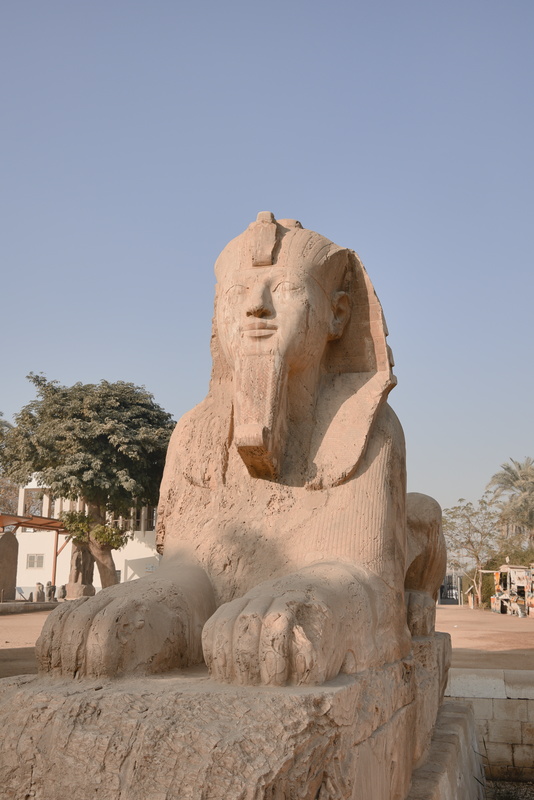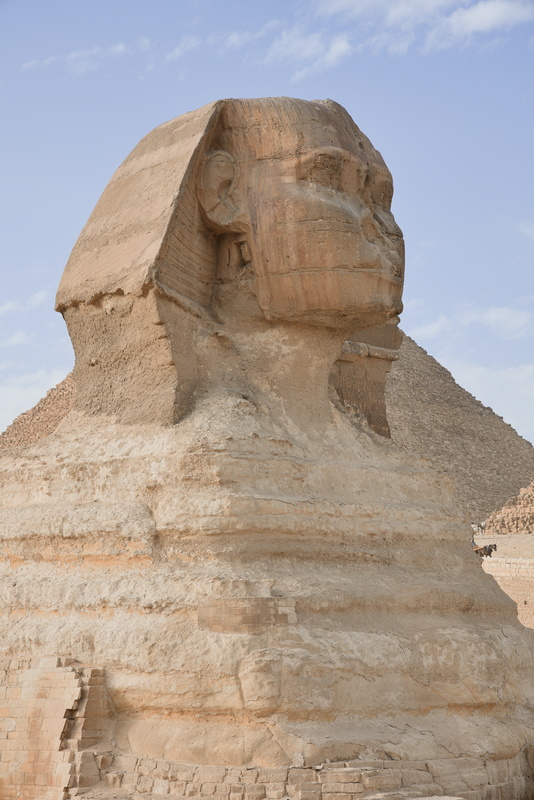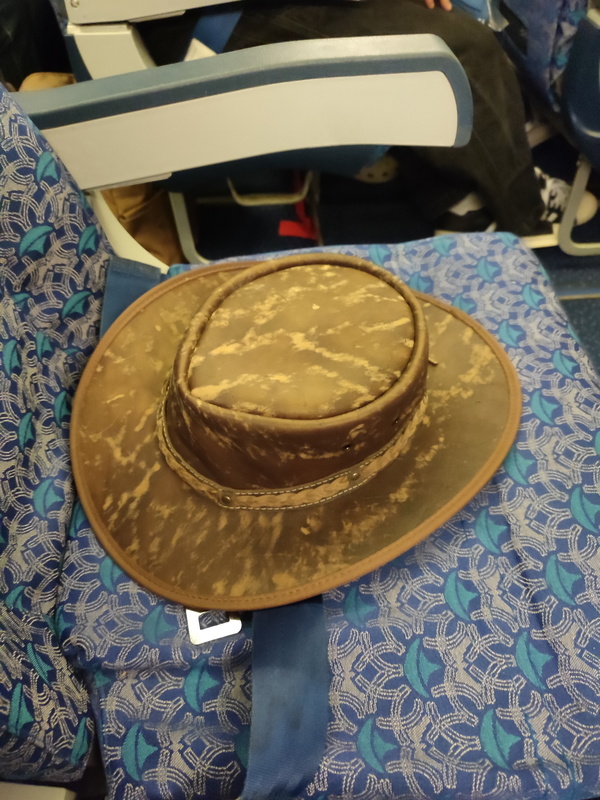How Doth the Little Crocodile...
⬅ previous ⬆intro next ➡Day 3 ~ January 22 ~ Cairo to Luxor
Today is going to be a very full day. We have lots to see and then we'll fly to Luxor where the main tour begins tomorrow.First, then, the Mit Rahina museum, ancient Memphis. You might be interested to know that Wikipedia tells us, "This modern name is probably derived from the late Ancient Egyptian name for Memphis mjt-rhnt meaning 'Road of the Ram-Headed Sphinxes'".

The Colossus of Rameses II.

This statue was not originally of Rameses II, but he seems to have renamed it after himself.
Rameses II, we are learning, was not a humble man.
Oh, note the people just behind the statue.

They're moving a block of stone using a scaled-down version of the ancient builders' technique. Or at least, what the ancients resorted to when they didn't have aliens in spacecraft with anti-gravity beams and laser cutters to help out.

This sphinx is one of the best-preserved examples at the site. A lot of it is still just ruins, and many of the better pieces that were found have been sold to other museums.
Now on to Saqqara, site of the Memphis necropolis.

Quite an imposing entrance.

Rawya points out a "spirit door". It's solid rock, but in the form of a door, so the spirits of the dead can pass through even if mere mortals can't.

Making offerings to the gods. Some big chunks of meat there, obviously seriously hungry gods!
Still, the priests probably did their duty to consume it on the gods' behalf.

In the funerary chamber of the Pyramid of Unas, the walls are completely covered in hieroglyphics, still retaining much of their original colour despite the passage of nearly four and a half thousand years. Although it was very far from the first pyramid to be built, it's the first that has these funerary texts.

The ceiling is covered in stars.

An attendant demonstrates the translucency of the alabaster.

He then insists on taking our picture with Amanda's phone.

Looking across an open space to the Step Pyramid of Djoser, the very first pyramid to be built. It was redesigned several times in the course of its construction, ending up slightly rectangular in plan rather than perfectly square.
The courtyard area was intended for the 'Heb-Sed' festival, when after thirty years of rule, a pharoah was expected to chase a sacred bull to prove his continuing vigour. It's likely, though, that Djoser didn't wait that long; unsurprisingly, few kings managed the full thirty years of reign.

Plenty of archaeology is happening all over the ancient sites.

The museum is named for Imhotep, believed to be the architect of the Step Pyramid.

Ancient measuring rods.
As you may or may not know, the metre used to be defined by a physical object called the "International Prototype Metre", which was kept in Paris and used to create copies which were then distributed to countries around the world to be their own national standards. The British copies, although no longer used as such, are still kept at the National Physical Laboratory, and I saw one at an open day some years back. These are basically the same thing, millennia apart.

A break for lunch.

And after lunch, the Great Pyramid of Khufu itself.
Entry inside the pyramid is an extra cost, mainly because not everyone wants to do it. We're told it's quite hard physically, because you have to climb a long ramp in a passageway too low to stand upright, and it's most definitely not for the claustrophobic. Lynda doesn't think she's up to it, but we and Rob are game.

This is the difficult section. Not quite crawling but not really walking, and while my hat isn't really protective headgear, it definitely saves me from a few bumps and scrapes.

Further along, it becomes possible to stand easily.
In the main chamber, photography is not allowed, although there's not really much to photograph. It's just an empty space with a few million tons of rock above your head.
Ah, wait, we are not allowed to take photographs, but that doesn't stop an enterprising attendant from taking them for us!

He tells us to pose in Egyptian style.

And then like this.

And like this!
Ok, ok, we'll give him a hundred Egyptian pounds as his tip. We tell him that's for Rob as well as us, as Rob hasn't got any cash on him, and although he tries to persuade us to pay twice, I think he's pushing his luck. He gives in with good enough grace when we refuse to negotiate.
Getting back down the tunnel is harder than coming up. Rob struggles a bit and eventually finds a method which is not quite bumping down on his backside but close enough. For better or for worse, I have no photographic record of this.

All three of the main pyramids with Cairo in the background.

The Great Sphinx is more badly eroded than I'd expected, though I'm not quite sure why.
Something I hadn't really been aware of is that the Greek and Egyptian concepts of the sphinx are very different. The Greek sphinx is a singular creature with the head of a woman, the body of a lion and the wings of an eagle, who will eat you if you can't answer her riddle. The Egyptian sphinxes are manifold, but generally male, wingless, and seen as powerful but benevolent symbols of strength.
Now you will recall that previously we visited the Egyptian Museum. Our next destination is the Grand Egyptian Museum. It's not yet properly open, and only a few areas can be visited, but they have an immersive Tutankhamun video exhibition which we are booked into for early evening.

It's an undeniably impressive atrium.

Looking back at the entrance reflected in a long pool.

And a fine view of Giza.
The Tutankhamun show is moderately entertaining, but it doesn't really tell us anything Rawya hasn't already, and I wouldn't go overboard recommending it.
The museum definitely looks like it'll be something special when it's finally finished, but there have been a lot of delays already and who knows how many more there might be.

Night is falling as we leave.
We are now off to the airport to fly to Luxor.

Not such a crowded flight this time. My hat has a seat to itself. [This is not a completely random picture: see this previous blog for comparison.]
The flight is uneventful, but when we get to Luxor we're definitely ready for bed.
We've learnt that there are three other people joining the group, but they've come direct from the UK and their flight arrived a little before ours. They've already gone to the hotel (and presumably to bed), so we won't meet them until tomorrow.
⬅ previous ⬆intro next ➡